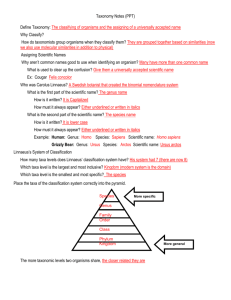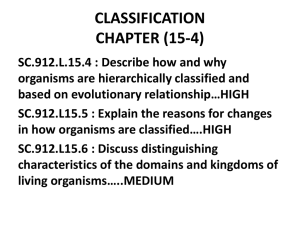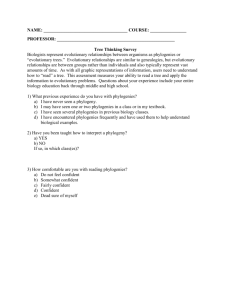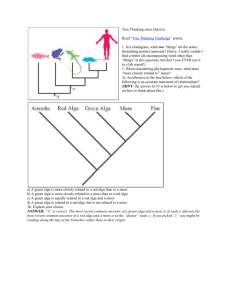Unit 8 Notes “Taxonomy” Textbook Chapter 17
advertisement
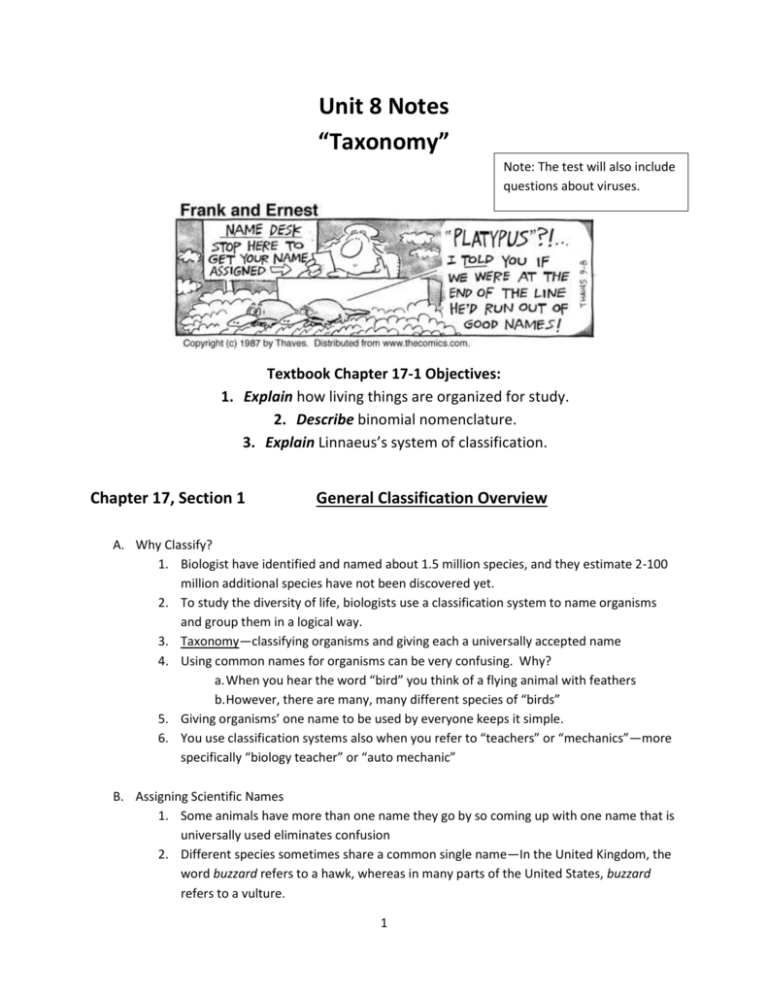
Unit 8 Notes “Taxonomy” Note: The test will also include questions about viruses. Textbook Chapter 17-1 Objectives: 1. Explain how living things are organized for study. 2. Describe binomial nomenclature. 3. Explain Linnaeus’s system of classification. Chapter 17, Section 1 General Classification Overview A. Why Classify? 1. Biologist have identified and named about 1.5 million species, and they estimate 2-100 million additional species have not been discovered yet. 2. To study the diversity of life, biologists use a classification system to name organisms and group them in a logical way. 3. Taxonomy—classifying organisms and giving each a universally accepted name 4. Using common names for organisms can be very confusing. Why? a. When you hear the word “bird” you think of a flying animal with feathers b. However, there are many, many different species of “birds” 5. Giving organisms’ one name to be used by everyone keeps it simple. 6. You use classification systems also when you refer to “teachers” or “mechanics”—more specifically “biology teacher” or “auto mechanic” B. Assigning Scientific Names 1. Some animals have more than one name they go by so coming up with one name that is universally used eliminates confusion 2. Different species sometimes share a common single name—In the United Kingdom, the word buzzard refers to a hawk, whereas in many parts of the United States, buzzard refers to a vulture. 1 3. Latin is the language used in naming organisms. 4. Early Efforts at Naming Organisms a. The first attempts at standard scientific names often described the physical characteristics of a species in great detail; as a result, these names could be twenty words long! b. For example, the English translation of the scientific name of a particular tree might be “Oak with deeply divided leaves that have no hairs on their undersides and no teeth around their edges.” c. This system had another major drawback—it was difficult to standardize names of organisms because different scientists described different characteristics. 5. Binomial Nomenclature a. Carolus Linnaeus was a Swedish botanist living in the 18th century b. He developed a two-word naming system called binomial nomenclature c. The scientific name is always written in italics; if it cannot be written in italics, it is always underlined! d. The first word is capitalized and the second word is lowercased e. For example, a grizzly bear (common name) has the scientific name Ursus arctos 1. The first part of the scientific name (Ursus) is the genus 2. The second part of the scientific name (arctos) is the species 3. Genus—group of closely related species; first name—in the grizzly bear example, the genus Ursus contains five other kinds of bears, including Important!!!! Ursus maritimus, the polar bear. 4. Species—group of similar organisms that can reproduce; second name—is unique to each species within the genus; a. Often this part of the name is a Latinized description of some important trait of the organism or an indication of where the organism lives. b. The Latin word maritimus, referring to the sea, comes from the fact that polar bears often live on pack ice that floats in the sea C. Linnaeus’s System of Classification 1. Linnaeus created a 7 level hierarchical system of classification called a taxon. a. Kingdom-Animalia b. Phylum-Chordata c. Class-Mammalia d. Order-Carnivora e. Family-Ursidae f. Genus-Ursus g. Species-Ursus arctos 2. Kingdom a. largest and most inclusive of Linnaeus’s taxonomic categories b. two kingdoms: Animalia and Plantae 2 3. Phylum a. Several different classes make up a phylum b. Includes many different organisms that nevertheless share important characteristics (body plant and internal functions) 4. Class a. Composed of similar orders b. For example, order Carnivora is placed in the class Mammalia, which includes animals that are warm-blooded, have body hair, and produce milk for their young. 5. Order a. Broad taxonomic category b. Composed of similar families 6. Family a. Group of genera (genus) b. Grizzly bear case: Ursidae 3 Textbook Chapter 17-2 Objectives: 1. Explain how evolutionary relationships are important in classification. 2. Identify the principle behind cladistic analysis. 3. Explain how we can compare very dissimilar organisms. Chapter 17, Section 2 Modern Evolutionary Classification **Important: The basic method of modern classification is structure and ancestry. A. Evolutionary Classification 1. Phylogeny—evolutionary relationships among organisms 2. Biologists group organisms into categories that represent lines of evolutionary descent 3. Evolutionary classification—strategy of grouping organisms together based on their evolutionary history 4. Species within a genus are more closely related to each other than to species in another genus. 5. The higher the level of the taxon, the farther back in time is the common ancestor. By reference to the tree above, which of the following is an accurate statement of relationships? a) A green alga is more closely related to a red alga than to a moss b) A green alga is more closely related to a moss than to a red alga c) A green alga is equally related to a red alga and a moss d) A green alga is related to a red alga, but is not related to a moss 4 Which of the five marks in the tree above corresponds to the most recent common ancestor of a mushroom and a sponge? In the above tree, assume that the ancestor had a long tail, ear flaps, external testes, and fixed claws. Based on the tree and assuming that all evolutionary changes in these traits are shown, what traits does a sea lion have? a) long tail, ear flaps, external testes, and fixed claws b) short tail, no ear flaps, external testes, and fixed claws c) short tail, no ear flaps, abdominal testes, and fixed claws d) short tail, ear flaps, abdominal testes, and fixed claws e) long tail, ear flaps, abdominal testes, and retractable claws B. Classification Using Cladograms 1. Cladistic analysis—identifies and considers only those characteristics of organisms that are evolutionary innovations—new characteristics that arise as lineages evolve over time 2. Derived characters—characteristics that appear in recent parts of a lineage but not in its older members 5 3. Cladogram—diagram that shows the evolutionary relationships among a group of organisms; useful tools that help scientists understand how one lineage branched form another in the course of evolution. 4. Just as a family tree shows the relationships among different lineages within a family, a cladogram represents a type of evolutionary tree, showing evolutionary relationships among a group of organisms After which animals did mammary glands develop? What animal does not have jaws? Which animals have lungs? Which animals would come before the hagfish? Are the perch and the lizard or the pigeon and mouse more closely related? C. Similarities in DNA and RNA 1. The genes of many organisms show important similarities at the molecular level. Similarities in DNA can be used to help determine classification and evolutionary relationships. 2. DNA Evidence a. The more similar the DNA sequence of two species, the more recently they shared a common ancestor, and the more closely they are related in evolutionary terms b. The more two species have diverged from one another, or changed in comparison to one another during evolution, the less similar their DNA will be. 6 c. Practice Questions 1. 2. According to the Mitochondrial DNA Analysis below, which two organisms are most closely related? D. Molecular Clocks 1. Model that uses DNA comparisons to estimate the length of time that two species have been evolving independently. 7 E. Additional Practice 1. What does all life stem from according to this picture? What major group came before animals? What group are mammals from? Which came first the chicken or the egg? Which animals are considered vertebrates? What organisms are non-flowering plants closely related to? What organisms are insects closely related to? 8 Textbook Chapter 17-3 Objectives: 1. Name the six kingdoms of life as they are now identified. 2. Describe the three-domain system of classification. Chapter 17, Section 3 Kingdoms and Domains A. The Tree of Life Evolves 1. In recent years, more research was done on microorganisms and biologists came to recognize that the Monera were composed of two distinct groups: Eubacteria and Archaebacteria a. 6 kingdoms were then created b. Eubacteria c. Archaebacteria d. Protista e. Fungi f. Plantae g. Animalia 2. Key Points: a. More complex organ systems indicate a more evolved organism 1. Example: Sponge vs. Fish, Shark vs. a Hagfish, etc. b. Shared characteristics within a common classification may indicate a common ancestor 1. Example: A Shark is more closely related to a Hagfish than a dolphin B. Kingdoms 1. Eubacteria a. Unicellular and prokaryotic b. Cells have thick, rigid cell walls that surround a cell membrane c. Ecologically diverse, ranging from free-living soil organisms to deadly parasites d. Some photosynthesize while others do not e. Some need oxygen to survive, while others are killed by oxygen 9 2. Archaeabacteria a. Unicellular and prokaryotic b. Live in some of the most extreme environments you can imagine—volcanic hot springs, brine pools, and black organic mud totally devoid of oxygen c. Many of these bacteria can survive only in the absence of oxygen 3. Protista a. Eukaryotic organisms that cannot be classified as animals, plants, or fungi b. Least satisfying classification because its members display the greatest variety c. Most protists are unicellular but some are multicellular algae d. Some protists are photosynthetic, while others are heterotrophic 4. Fungi a. Heterotrophs b. Most feed on dead or decaying organic matter c. Most recognizable fungi include mushrooms—multicellular d. Some fungi, such as yeast, are unicellular 5. Plantae a. Multicellular that are photosynthetic autotrophs b. Have cell walls that contain cellulose c. Plant kingdom includes cone-bearing and flowering plants as well as mosses and ferns 6. Animalia a. Multicellular and heterotrophic b. Cells do not have cell walls C. Contrasting how Different Kingdoms Obtain and Convert Energy Kingdom Fungi Method of Obtaining Energy Absorption or Chemosynthesis Absorption, Photosynthesis, or Chemosynthesis Absorption, Photosynthesis, or Ingestion Absorption Plantae Photosynthesis Autotroph Animalia Ingestion Heterotroph Archaebacteria Eubacteria Protista Nutrition Autotroph or Heterotroph Autotroph or Heterotroph Autotroph or Heterotroph Heterotroph Characteristics/ Organisms Has cell wall but no nucleus; lives w/o oxygen in extreme environments; Extreme and extinct bacteria Has cell wall (differs slightly from wall of Archaeabacteria, but no nucleus; bacteria, blue-green algae Has nucleus and membrane, may or may not have a cell wall, may or may not have chloroplasts; euglenas, singlecelled algae, amoebas, paramecia Has cell wall, nucleus, and membrane but no chloroplasts; yeast, mushrooms Has cell wall, nucleus, membrane, and chloroplasts; mosses, trees, ferns, flowers Has nucleus and membrane, but no cell wall or chloroplasts; sponges, fish, reptiles, birds, mammals 10 11



